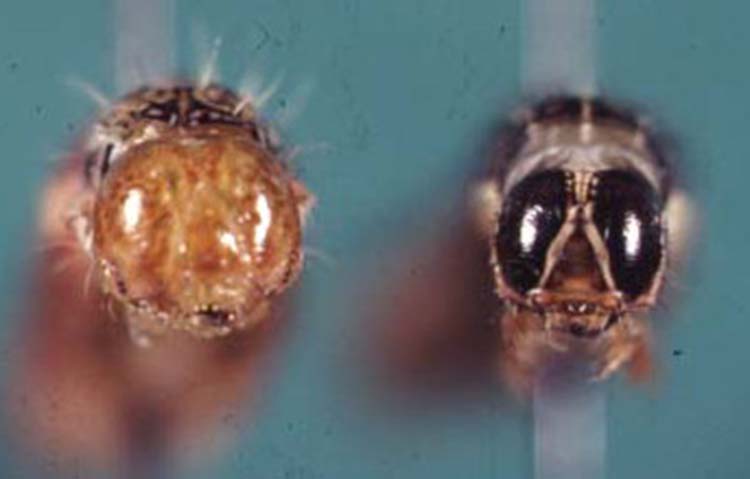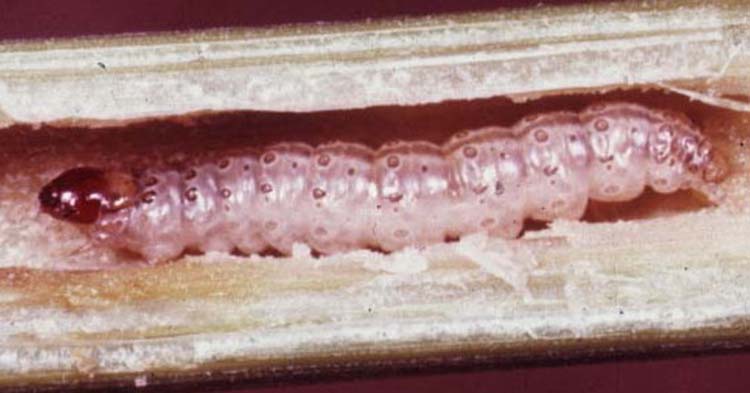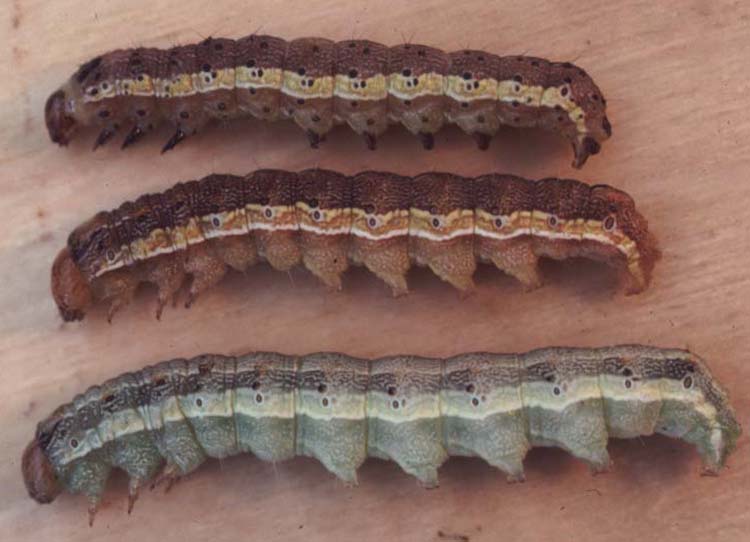Corn earworm, Fall armyworm, and European corn borer caterpillars can all infest the ears of sweet corn. The most reliable way to identify them is to examine the heads of the caterpillars.
Corn earworm caterpillars have a uniform light yellow-brown head. Fall armyworm caterpillars have distinctively marked heads—when viewed from the front, there is an upside down white Y which divides the head into three regions. The low (middle) region is light; and the left and right regions are dark. This is visible even on very small caterpillars. European corn borer caterpillars have dark brown heads, with no visible white Y.

Right - Fall armyworm caterpillar
European Corn Borer
Head capsule: Dark brown.
Body: Light colored, often tinted pink, tan or gray, with a pattern of small darker spots on each segment. Fully grown larvae are ¾ to 1 inch long.They can be in the whorl, in or on the tassel, in stalks, or in the ears.

Corn Earworm
Head capsule: Light yellowish brown.
Body: May be green, yellow, tan, brown, orange or pink with light and dark longitudinal stripes. Small bumps and hairs covering the surface may give the body a rough texture. Fully grown larvae are 1 ½ to 2 inches long. They can be found inside the ears or in the silk channel. This insect does not feed on the leaves.

Fall Armyworm
Head capsule: Dark with a prominent, light colored area shaped as aninverted Y.
Body: Tan, green or almost black and smoother than corn earworm. Light and dark stripes run the length of the body. Four small black spotsare visible on most segments. On the last posterior segment, the four spots form a conspicuous square pattern. Fully grown larvae are about 1 ½ inches long. This insect does extensive feeding on leaves, stalks, silks, tassels, husks and/or ears, if they are young and tender. It leaves many large, messy droppings.

There are other caterpillars (or caterpillar-look-alikes) that you might find in ears of corn in New Hampshire. Western bean cutworm is an insect that has spread to New England. They are not very common. The larvae feed on leaves, tassel, pollen, silk, and kernels. You might find more than one in one ear. They have two broad brown stripes on the dorsal part of the pronotum… the segment just behind the head. Body color is variable, but usually brown or tan.

Sap beetle larvae are sometimes mistaken for small corn borers. They are very small (up to 12mm [almost ½ inch]) cream or light tan larvae with brown heads. They have a brown, rear body section with two or four protruding points. They have only six legs, while caterpillars have six true legs on the thoracic section of the body, and many pairs of fleshy legs (“prolegs”) on the abdomen. Sap beetle larvae are most common when there have been good conditions for yeast to be introduced and grow inside the husks. Sometimes other insects attacking the ear will create those conditions.
This publication was supported in part by IPM grants from the New Hampshire Department of Agriculture, Markets and Food, and the National Institute for Food and Agriculture, United States Department of Agriculture.
Photo credits: Clemson State University: corn borer larva. Richard Clark, III: corn earworms. Alan T. Eaton: fall armyworm, head capsules and sap beetle larva. Frank Peairs, Colorado State University, took the photo of the western bean cutworm caterpillar, which we accessed through www.bugwood.org.
Download the Resource for the complete fact sheet and a printable version.

